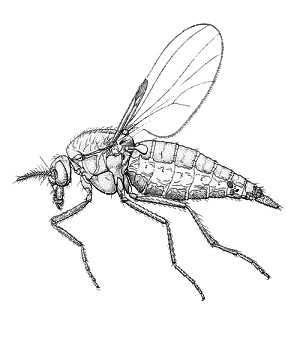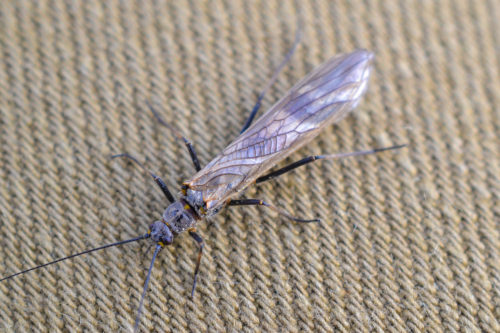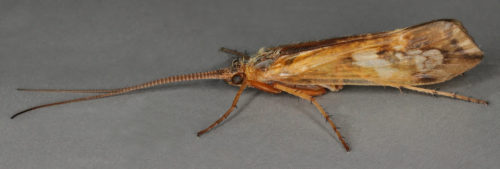Winter Insects in the North Cascades

For weeks here in the North Cascades, the ground has been blanketed in a thick layer of snow and ice, two or three feet deep in places. It is not the kind of weather in which you’d expect to see many insects out and about—and indeed, most insects go into a dormant phase in the winter, surviving the season in a state of suspended torpor as eggs, larvae, or adults. Yet it turns out that some insects will brave the snow and venture out in near-freezing temperatures.
After some of our recent snowfalls, I’ve gone snowshoeing and found winter insects alive and well, crawling about on the recently fallen snow crystals. Below are a few of the insect species you might encounter in the North Cascades even in the depths of winter:

Illustration of a midge or ‘no-see-ums’ courtesy of Wikipedia
Midges – In late January, fellow graduate M.Ed student Dan Dubie and myself went out hunting for midges after we noticed several of the tiny insects flying outside the window of the North Cascades Institute Environmental Learning Center dining hall. Midges are a type of true fly, meaning they belong to the same family as house flies, bluebottles, mosquitoes, and hundreds of other insects with a single pair of wings. Midges are among the smallest and most delicate members of the fly order, making it all the more impressive that they can survive in winter.
First we set out to find where the midges were coming from. Most midges spend the first part of their life cycle underwater, so I went down to the shore of Lake Diablo to look for signs of them. There, I found what appeared to be the shed pupal casings of a small insect floating in the water. I hypothesized that the midges we’d seen were recently-emerged adults that came out of these cases, just as a butterfly emerges from a chrysalis.
We next caught several in small jars, and I later examined them under a microscope to try to identify them. While I can’t be 100% positive (tiny insects are extremely difficult to identify, and in many cases only experts can make the call with certainty), I’m fairly confident the midges we found belong to the family Ceratopogonidae, the “no-see-ums.” They are also known as biting midges—but they never bit me, leading me to think this particular species must feed on animals other than humans.
In fact most midges, even those belonging to Ceratopogonidae, are completely harmless to people. Midges and other flies are among the most under-appreciated of insects, but they are an important part of the ecosystem and their ability to be active in winter testifies to their tenacity.
lace-front-wigs-wigisfashion ;
lace-front-wigs-blackhairspray ;
lace-front-wigs-lacewigsbuy ;
lace-front-wigs-wowafrican ;
laced hair extensions
lace-front-wigs-hairstopandshop ;
lace-front-wigs-myhairon ;
remy hair extensions
lace-front-wigs-hairtobeauty ;
lace-front-wigs-discountbeautydepot ;
blonde hairstyles
halo extensions
omywigs

A winter stonefly courtesy of Wikipedia
Winter stoneflies – On February 4th, after a recent heavy snowfall, I went snowshoeing on the Deer Creek Trail. I was surprised to find several stoneflies, apparently of two different species, crawling on the snow. Stoneflies belong to one of the more “primitive” insect groups, meaning they look not unlike some of the first insects on Earth may have appeared. Many species seem to have flattened bodies, and they fold two pairs of long wings over their backs. Juvenile stoneflies, like midges, live in the water and do not emerge until adulthood.
The majority of adult stoneflies are spring and summer insects—but it turns out some species emerge in winter. Some members of the family Taeniopterygidae, or “winter stoneflies” emerge as early as January and I believe some of the specimens I saw belonged to this group. There are also the “small winter stoneflies,” of the family Capniidae, which as their name suggests tend to be rather diminutive in size. I believe most of the stoneflies I saw belonged to this family, since they were quite small and had long “cerci,” or tail prongs—a distinguishing feature of this family.
Based on where I found them, my guess is both stonefly species I saw emerged from Deer Creek, a small, fast-flowing stream that did not ice over this winter, and which would provide ideal habitat. The presence of stoneflies in a body of water is usually a sign of excellent stream health, so that’s good news for Deer Creek.

A snow sedge courtesy of Wikipedia
Snow sedge – A couple days after spotting the stoneflies, I was surprised to find several larger, moth-like insects with long antennae on the snow around the Environmental Learning Center. I immediately identified them as members of the caddisfly order, yet another group of insects with an aquatic juvenile form. Making a more specific identification proved challenging, even with a microscope; the process of positively identifying caddisflies involves counting the segments in their legs and mouthparts, which can be very hard to do.
Despite these hurdles, I’m pretty confident that the caddisflies I found were snow sedges, a member of the northern caddisfly family, or Limnephilidae. The giveaway characteristics were the insects’ relatively large size (about an inch long) and their mottled wing coloration. These traits are not as reliable as mouthpart segments for making an identification, but they’re good enough that I feel pretty sure a snow sedge is what I was looking at.
As their family name suggests, northern caddisflies are usually found in the northerly parts of this continent, some as far north as Alaska. Some species are even bigger than the ones I found, up to about two inches long. The caddisflies I found might have emerged from any of the various bodies of water around the Environmental Learning Center.
As the above examples show, there is plenty of insect life to be found in the North Cascades, even during the coldest part of the year. Heavy snow and near-freezing daytime temperatures are not enough to keep all insects confined to a torpid state. Looking for winter insects is an enjoyable naturalist activity and a great way to appreciate the perseverance of life in the wintertime.
Written by Nick Engelfried, graduate M.Ed. student at North Cascades Institute.


Very interesting and well written. Thanks for sharing.